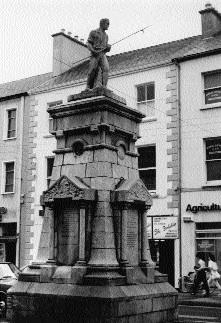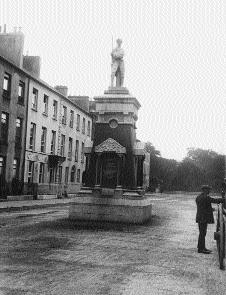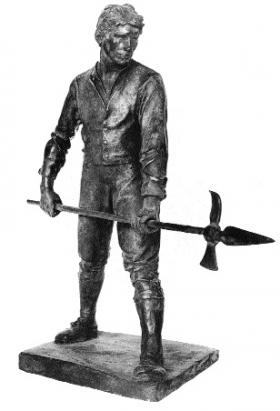THE PIKEMAN OF TRALEE: A Tale of Continuity and Change
Published in 18th–19th - Century History, Issue 2 (Summer 1998), News, The United Irishmen, Volume 6
Fig.1 The Pikeman of Tralee, Denny Street—unveiled in June 1939.

Fig.2 The original Pikeman, unveiled in 1905, was destroyed by Black and Tans in 1921. (Lawrence Collection, National Library of Ireland)
popular imagination monuments appear to be timeless and unchanging. Once erected they quickly become a ‘natural’ fixture in the landscape. Highly visible and inhabiting a public space they encourage the viewer, as one writer has pointed out, ‘to mistake material presence and weight for immutable permanence’. Yet these silent, still, stone and bronze edifices have tales to tell; tales which contradict that enduring impression. The history of the Pikeman of Tralee provides a good example. Kerry’s memorial to the men who fought and died for Ireland in 1798 is located in Denny Street, Tralee (fig.1). A full-length figure, with purposeful expression in the act of striding forward, the pikeman radiates the sense of purpose and defiance befitting the commemoration of an armed rebellion. The memorial not only commemorates the men of ‘98 but, as the panels on the elaborately designed pedestal indicate, also the risings of 1803, 1848 and 1867. Unveiled on 6 June 1939 it quickly became a permanent landmark in Tralee.
It was not the first ‘98 monument to be erected in Denny Street. It replaced one unveiled in 1905 (fig.2). In 1901, in the climate of resurgent nationalism following the centenary celebrations of the 1798 Rebellion, the Kerry County Board of the GAA decided to initiate a movement for the erection of a ‘98 memorial in Tralee. A local stonemason was commissioned to carve the statue and plinth. The figure depicts a young pikeman, alert and at the ready. This statue remained in place until 1921 when, during the War of Independence, Black and Tans dragged it from its pedestal and smashed it. Six years later a local committee, three of whom comprised members of the original committee, decided to replace it. Rather than hire a local stone carver, the renowned Kerry-born international sculptor, Jerome Connor, was invited to sculpt the replacement figure. But he delayed so long in completing the commission, being dissatisfied with his initial design (fig.3), that the committee took him to court. Albert Power, a highly regarded Dublin sculptor was subsequently called upon to complete the scheme. By June 1939 this third pikeman was ready for unveiling. Power’s figure, in terms of its design, recalls that of Connor, and, as one would expect of highly-trained professional artists, theirs are altogether more convincing representations than the original.
Visible in both completed monuments is a common feature associated with full-length sculpted figures in the round. It was standard practice to create a prop, usually in the guise of a tree-trunk, to prevent statues from breaking at their weakest point. Unusually though in the case of Power’s pikeman, the artist was to ascribe it an ideological importance:
…this man represents his country, the man who had lost everything. His house has been burnt, everything has been taken away from him. There is nothing remaining to him but the roots of his trees. Yet he is standing on the roots which support his claim to right and justice and faces life sure of conquering. This man is Ireland.

Fig.3 Jerome O’Connor’s Pikeman—lost the commission due to delays.
(Liam Kennedy, ESB)
What is revealed here are not only Power’s own strong patriotic views, but those of the committee and others supporting the venture—a need to romanticise the past as a heroic struggle against insuperable odds. In the Ireland of the 1930s, when people were trying to put the horrors of the Civil War behind them, the glorification of past national sacrifice provided a comforting diversion from having to confront the country’s less commendable contemporary blood-letting.
On the occasion of the unveiling of the foundation stone for the first monument in 1902, Maud Gonne McBride was asked to perform the ceremony. Thirty-seven years later she was back to unveil the replacement. Her speeches at both events provide an illuminating insight into the unchanging nature of her personal political aspirations, aspirations which inevitably clashed with the shifting character of political life in Ireland in the first three decades of this century. For her the necessity of fighting for Ireland’s full independence was paramount, a freedom which she saw in quasi-religious terms. In the earlier speech she talks of ‘the holy cause of freedom’ while in 1939 she argues that it is the duty of Christians to overcome the British Empire which ‘represents for us the world, the flesh and the devil’. By the time of the second unveiling however the whole political climate in Ireland had changed. Independence had been granted to most of the island. Gonne McBride’s continued exhortation to the crowd, particularly the young, to fight for Ireland’s freedom was now out of kilter with the new political reality. She chose to ignore the fact that most people, sickened by the atrocities of the Civil War, shunned the kind of violence she so ardently sought. This later speech also exposes the changed nature of former republican associations. She believed that Eamon de Valera and his followers had betrayed republican ideals by their decision to engage in constitutional politics in the wake of the Civil War. In her address she bitterly denounced her former allies, now the leaders of the nation, accusing them of having ‘succumbed to the forces of corruption of the British Empire’. They were also charged with having colluded with the British establishment in calling republicans currently involved in a bombing campaign in England ‘terrorists and murderers’.
The Pikeman of Tralee, like other monuments of its kind, acts as a fascinating barometer of the cultural and political climate at the time of its production and later. It also reveals a contradictory feature of public monuments, where embodied in a single symbolic form, the permanent and impermanent become interchangeable.
Sighle Bhreathnach-Lynch is a free-lance art historian currently researching a book on early twentieth-century Irish sculpture.
















